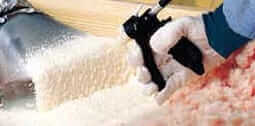AWF Blog
How to choose the right foam insulation: High-Density Foam vs. Low-Density Foam
Posted by Carmen T. on Mar 20th 2024
Are you considering foam insulation for your home or business but need clarification on the differences between high-density and low-density options? Understanding the key differences can help you make an informed decision that suits your project's needs. Let's explore the characteristics of each type to help you choose the correct foam insulation for your needs.
Density:
- Low-density foam has a lower density, meaning fewer lbs. per cubic foot; in this instance, our Froth Pak 200, 210, 620, and 650 have a density of 1.75 lbs. / cu. Ft.
- High-density foam has a higher density; in this instance, our Froth Pak 115 has a density of 2.75 lbs. / cu. Ft.
Structural Support:
- Low-density foam insulation is less dense and does not offer significant structural support. The product is more flexible and suitable for insulating walls, crawl spaces, or irregular surfaces.
- High-density foam insulation provides structural support due to its denser composition, making it suitable for applications where this is a priority. An excellent example of this is roofing.
Thermal Resistance:
- Low-density foams (Froth-Pak 200, 210, 620, and 650) provide an R-Value of 6.2 Per inch
- High-density foams (Froth-Pak 115) provide an R-value of 6.8 Per Inch
Flexibility and Handling:
- Low-density foam is more flexible & lightweight, making it easier to handle and install. It can conform to irregular spaces and fill voids effectively.
- High-density foam insulation is heavier and less flexible but offers excellent stability and durability.
Application Areas:
- Low-density foam is applied in the following:
- Stud wall cavities
- Rim or band joists
- Crawl space walls and ceilings
- Attic ductwork
- Plumbing wall pipe insulation and support
- Residential building
- Commercial building
- High-density foam is applied in the following:
- Residential building
- Commercial building
- Roof foam repair
- Insulated trailer and container repair
- Rail car repair
- Ship and boat applications
Low-Density Foam Insulation has a softer composition and less dense structure. It is flexible and lightweight, making it easier to handle and install. It conforms to irregular surfaces and fills gaps effectively. Although it is less dense, low-density foam still provides excellent thermal resistance in applications where structural support is not a primary concern, such as crawl spaces, walls, and around windows and doors.
High-Density Foam Insulation provides excellent thermal resistance, making it highly effective at keeping heat in during the winter and out during the summer. Due to its dense nature, it provides structural support when used in walls, roofs, and other structural elements, helping enhance your building while providing insulation. It is well suited for areas requiring robust insulation, such as exterior walls, attics, and roofing systems—offering long-lasting performance and durability.
Selecting the correct option:
When selecting foam insulation for your project, consider the specific requirements and priorities.
Low-density foam is the perfect choice for applications where flexibility and ease of application due to the surface are essential. If you need structural support, high-density foam is the ideal choice.
It's important to note that both foams have specific applications and offer unique benefits and strengths. Overall, the product choice is specific to the needs and size of the project. Following the manufacturer's guidelines for your particular foam product is crucial. The information provided here is general, and performance can vary depending on the product and application conditions.
Definition:
Density is how much space an object or substance takes up (its volume) to the amount of matter in that object or substance (it's mass). Another way to explain this is that density is the amount of mass per unit of volume.
R-value is the product's thermal resistance and it measures the level of resistance to heat flow a given material or an assembly can offer as a result of suppressing conduction, convection, and radiation





